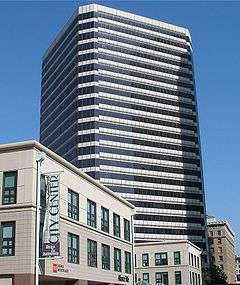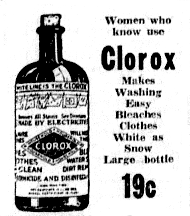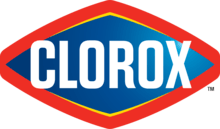Clorox
The Clorox Company (formerly Clorox Chemical Company), based in Oakland, California, is an American global manufacturer and marketer of consumer and professional products,[12] with approximately 8,700 employees worldwide, as of June 30, 2018.[11] Net sales in the company's 2019 fiscal year were US$6.2 billion.[8] Clorox ranked No. 468 on Fortune's 2018 Fortune 500 list.[13][14][15]
 | |
 Clorox Building, 1221 Broadway, Oakland, California | |
Formerly | Electro-Alkaline Company (1913–1928) Clorox Chemical Company (1928–1957) |
|---|---|
| Public company | |
| Traded as | NYSE: CLX S&P 500 Component |
| ISIN | US1890541097 |
| Industry | Consumer household products Healthcare Food |
| Founded | May 3, 1913 |
| Founders |
|
| Headquarters | Clorox Building, Oakland, California , US |
Area served | Worldwide |
Key people | Benno Dorer (Chairman and CEO) Pamela Thomas-Graham (lead independent director) |
| Products | Cleaning food storage/trash bags food cat litter charcoal dietary supplements digestive health personal care healthcare water filtration |
| Brands | Burt's Bees Formula 409 The Glad Products Company Kitchen Bouquet Kingsford Lestoil Liquid-Plumr Pine-Sol Nutranext Renew Life Hidden Valley Ranch Fresh Step Brita Poett |
| Revenue | |
| Total assets | |
| Total equity | |
Number of employees | |
| Parent | Procter & Gamble (1957–1969) Henkel Corporation (29% percent stake, divested) |
| Website | thecloroxcompany |
| Footnotes / references [3][4][5][6][7][8][9][10][11] | |
Clorox products are sold primarily through mass merchandisers, retail outlets, e-commerce channels, distributors, and medical supply providers.[16] Clorox brands include its namesake bleach and cleaning products, as well as Burt's Bees, Formula 409, Glad, Hidden Valley, Kingsford, Kitchen Bouquet, KC Masterpiece, Liquid-Plumr, Brita (in the Americas), Mistolin, Pine-Sol, Poett, Green Works Cleaning Products, Soy Vay,[17][18] RenewLife,[19] Rainbow Light, Natural Vitality, Neocell,[20] Tilex, S.O.S., and Fresh Step, Scoop Away, and Ever Clean pet products.[17][18]
History
1913–1927
The beginnings of Clorox bleach and the company date back to May 3, 1913, when five entrepreneurs, Archibald Taft, a banker; Edward Hughes, a purveyor of wood and coal; Charles Husband, a bookkeeper; Rufus Myers, a lawyer; and William Hussey, a miner, invested $100 each to set up the first commercial-scale liquid bleach factory in the United States, on the east side of San Francisco Bay.[21] The firm was first called Electro-Alkaline Company.[21] The name of its original bleach product, Clorox, was coined as a portmanteau of chlorine and sodium hydroxide, the two main ingredients. The original Clorox packaging featured a diamond-shaped logo, and the diamond logo has been used in one form or another in Clorox branding to the present.

The public, however, did not know very much about liquid bleach when Clorox bleach debuted. Although the Electro-Alkaline Company started slowly and was about to collapse quickly, it would not be until 1916 when investor William Murray took over the company as general manager. His wife, Annie Murray, prompted the creation of a less-concentrated liquid bleach for home use and built customer demand by giving away 15-ounce sample bottles at the family's grocery store in downtown Oakland.[22] Not long after, word began to spread and, in 1917, the Electro-Alkaline Company began shipping Clorox bleach to the East Coast via the Panama Canal.
1928–1960s
On May 28, 1928, the company went public on the San Francisco stock exchange and changed its name to Clorox Chemical Company. Butch, an animated Clorox liquid bleach bottle, was used in its advertising and became well-known, even surviving the 1941 transition from rubber-stoppered bottles to screw-off caps.[23]
Clorox was strong enough to survive the Great Depression throughout the 1930s, achieving national distribution of Clorox bleach in the process, but during World War II, even though Clorox bleach proved useful as a first aid product for American armed forces, one of the bleach's ingredients was being rationed, as, under U.S. government orders, chlorine gas shortages forced many bleach manufacturers to reduce the concentration of sodium hypochlorite in their products, thus diluting them with water. Clorox, however, declined and elected to sell fewer units of a full-strength product, establishing a reputation for quality.[23]
In 1957, Clorox was purchased by Procter & Gamble, which renamed its new subsidiary The Clorox Company. Almost immediately, a rival company objected to the purchase, and it was challenged by the Federal Trade Commission, which feared it would stifle competition in the household products market. The FTC won in 1967 after a 10-year battle, in which the U.S. Supreme Court ruled that P&G must divest Clorox,[24] and on January 1, 1969, Clorox became independent again.
1970s–1990s
Throughout the 1970s and 1980s, Clorox pursued an aggressive expansion program in which it attempted to establish itself as a major diversified consumer products conglomerate, like Proctor & Gamble. In 1970, Clorox introduced Clorox 2 all-fabric bleach. Later on, in that period, it acquired a number of brands that remain a part of their portfolio today, including Formula 409, Liquid-Plumr, Kingsford charcoal and developed cleaning products such as Tilex instant mildew remover.[25] It even acquired a ranch dressing that was still new to the market, which was known as "Hidden Valley."
In 1988, Clorox struck a licensing-and-distribution agreement that brought Brita water filters to the U.S.[25] The company acquired sole control of the brand for the U.S. and Canada in 1995 when it acquired Brita International Holdings (Canada). In 2000 it secured the remaining Americas market from Brita.[26]
In 1990, Clorox purchased Pine-Sol.[25]
In 1999, Clorox acquired First Brands, the former consumer products division of Union Carbide, in the largest transaction in its history. Such brands as Glad, Handi-Wipes (which First Brands acquired from Colgate-Palmolive several months before the Clorox acquisition) and STP became part of the Clorox portfolio. The First Brands acquisition doubled the size of the company and helped it land on the Fortune 500 for the first time the following year.[25]
2000s–present
During the next decade, the company focused on consumer megatrends that included sustainability, health and wellness, multicultural, and affordability/value.[27] In 2002, Clorox entered into a joint venture with Procter & Gamble to create food and trash bags, food wraps, and containers under the names Glad, GladWare and related trademarks.[28] As part of this agreement, Clorox sold a 10% stake in the Glad products to P&G, which increased to 20% in 2005.[29]
In 2007, the company acquired Burt's Bees.[30] In 2010, Clorox shed businesses that were no longer a good strategic fit for the company, announcing that it was selling the Armor All and STP brands to Avista Capital Partners.[31] In 2011, Clorox acquired the Aplicare and HealthLink brands, bolstering its presence in the healthcare industry.[32]
In 2008, The Clorox Company became the first major consumer packaged goods company to develop and nationally launch a green cleaning line, Green Works, into the mainstream cleaning aisle.[33] In 2011, the Clorox Company integrated corporate social responsibility (CSR) reporting with financial reporting. The company's annual report for the fiscal year ending in June 2011 shared data on financial performance as well as advances in environmental, social and governance performance.
The company ranked No. 453 on the Fortune 500 in 2017.[14][15][35][36] In 2018 Clorox purchased Nutranext Business, LLC for approximately $700 million. Florida-based Nutranext makes natural multivitamins, specialty minerals used as health aids, and supplements for hair, skin and nails.[37] Operating income in 2018 was United States Dollar1.1 billion.[38] With approximately 8,700 employees worldwide as of 2018, yearly revenue for the period ending June 30, 2018, equaled $6.1 billion.[11] Yearly revenue equaled $6.2 in 2019.[8] In 2019, Clorox ranked 7th in Barron’s “100 Most Sustainable U.S. Companies” list.[39]
In August 2020, The Clorox Company announced that Linda Rendle will be promoted to CEO and elected to the company's board of directors, effective September 14, 2020.[40]
Brands


The Clorox Company currently owns a number of well-known household and professional brands across a wide variety of products, among them:
- Brita water filtration systems (Americas only)[17][41]
- Burt's Bees natural cosmetics and personal care products[17]
- Formula 409 hard surface cleaners[17]
- Fresh Step, Scoop Away and Ever Clean cat litters[17]
- Glad storage bags, trash bags, Press'n Seal, GladWare containers (joint venture with P&G as 20% minority shareholder)[17]
- Green Works natural cleaners[17]
- Handy Andy floor cleaners in Australia[42]
- Hidden Valley dressings, sandwich spreads and condiments, dips and dressing mixes, croutons and salad toppings, side dishes and appetizers[17]
- Kingsford charcoal[17]
- Kitchen Bouquet, KC Masterpiece, and Soy Vay sauces[17]
- Lestoil heavy-duty laundry / multipurpose Cleaner[17]
- Liquid-Plumr drain cleaner[17]
- Natural Vitality[20]
- Neocell dietary supplements[20]
- Pine-Sol, Tilex, and S.O.S cleaning products[17]
- Rainbow Light[20]
- Renew Life digestive health products[19]
For historical reasons, and in certain markets, the company's bleach products are sold under regional brands. In 2006, Clorox acquired the Javex line of bleach products in Canada, and similar product lines in parts of Latin and South America, from Colgate-Palmolive.[43]
Clorox's net sales (2015–2019)
| FY 2019 | FY 2018 | FY 2017 | FY 2016 | FY 2015 | |
| US dollars (in millions) | $6,214[8] | $6,124[11] | $5,973[44] | $5,761[36] | $5,655[45] |
The ingredients in Clorox bleach are water, sodium hypochlorite, sodium chloride, sodium carbonate, sodium chlorate, sodium hydroxide and sodium polyacrylate.[46]
Corporate responsibility
For the first time, the company's annual report for the fiscal year ending in June 2011 shared data on financial performance as well as advances in environmental, social and governance performance. In 2015, the company became a signatory of the United Nations Global Compact, a large corporate responsibility initiative.[47]
Marketing
Allegations of sexist marketing
During 2006 and 2007, a Clorox commercial that aired nationally showed several generations of women doing laundry. The commercial included the words "Your mother, your grandmother, her mother, they all did the laundry, maybe even a man or two." Feminists criticized the commercial for insinuating that doing laundry is a job for women only.[50][51]
The Clorox slogan, "Mama's got the magic of Clorox", was criticized on similar grounds.[52] The slogan first appeared in a Clorox commercial in 1986.[53] A modified version of the commercial ran from 2002 to 2004.[54]
In 2009, Clorox received complaints of sexism for an advertisement that featured a man's white, lipstick-stained dress shirt with the caption, "Clorox. Getting ad guys out of hot water for generations."[55] The ad, and others, were produced expressly for the television program Mad Men, capitalizing on "the show's unique vintage style to [create] a link between classic and modern consumer behaviors."[56]
Reactions to product claims
Green Works
In 2008, the Sierra Club endorsed the Clorox Green Works line. Sierra Club Executive Director Carl Pope stated that one of non-profit organization's "primary goals is to foster vibrant, healthy communities with clean water and air that are free from pollution. Products like Green Works help to achieve this goal in the home." The Sierra Club also partnered with Clorox "to promote a line of natural cleaning products for consumers who are moving toward a greener lifestyle."[57] The partnership "caused schisms" in the club, which contributed in part to Pope's decision to resign.[58]
Also in 2008, the National Advertising Division told Clorox to either discontinue or modify its advertisements for Green Works on the grounds the cleaners actually do not work as well as traditional cleaners, as Clorox had claimed.[59]
In 2009, Clorox received further criticism for its Clorox Green Works line, regarding claims the products are environmentally friendly.[60] Several Clorox Green Works products contain ethanol, which environmental groups state is neither cost-effective nor eco-friendly.[60] Many Green Works products also contain sodium lauryl sulfate, a known skin irritant.[60] Women's Voices for the Earth have questioned whether or not the Clorox Green Works line is greenwashing, as Clorox's "green" products are far outnumbered by their traditional products, asking "Why sell one set of products that have hazardous ingredients and others that don't?"[61]
References
- Macrotrends Accessed March 4, 2020.
- Marketwatch Accessed March 4, 2020.
- "The Clorox Company Profile". Yahoo Finance. Retrieved December 30, 2015.
- Dulaney, Chelsey (May 15, 2015). "Former Clorox CEO Knauss Leaving Executive Chairman Post". The Wall Street Journal. Retrieved December 30, 2015.
- "Clorox shuffles boardroom as CEO adds chairman's role" – San Francisco Business Times (August 4, 2016) – accessed April 18, 2017
- Avalos, George (September 18, 2014). "Clorox names Dorer as new CEO". San Josey Mercury News. Retrieved December 30, 2015.
- Dulaney, Chelsey. "Former Clorox CEO Knauss Leaving Executive Chairman Post". The Wall Street Journal. Retrieved April 18, 2017.
- https://investors.thecloroxcompany.com/investors/news-and-events/press-releases/press-release-details/2019/Clorox-Reports-Q4-and-Fiscal-Year-2019-Results-Provides-Fiscal-Year-2020-Outlook/
- https://investors.thecloroxcompany.com/investors/news-and-events/press-releases/press-release-details/2018/Clorox-Reports-Q4-and-Fiscal-Year-2018-Results-Provides-Fiscal-Year-2019-Outlook/default.aspx
- "Clorox". Fortune. Retrieved December 31, 2018.
- NASDAQ stock report
- "Consolidated Statement of Earnings, The Clorox Company". Yahoo Finance. December 4, 2014. Retrieved December 16, 2014.
- https://web.archive.org/web/20181128083518/http://fortune.com/2018/05/21/clorox-5/. Archived from the original on November 28, 2018. Retrieved November 27, 2018. Missing or empty
|title=(help) - "Fortune 500 Companies 2017: Who Made the List". Fortune. Retrieved April 7, 2018.
- "2016 Fortune 500". Fortune. December 2016. Retrieved April 15, 2017.
- "Clorox Company (The) Stock Report". NASDAQ. Retrieved February 28, 2014.
- "Our Brands". The Clorox Company. Retrieved February 28, 2014.
- Morgan, Penny. "How Is Clorox Improving Product Distribution?". Market Realist. Market Realist. Retrieved April 18, 2017.
- Wahba, Phil. "Clorox Wants to Help Clean Up Your Digestion". Fortune. Retrieved April 18, 2017.
- https://wholefoodsmagazine.com/news/main-news/clorox-buy-nutranext-700-million/
- Clorox company history, page 1 Archived December 3, 2010, at the Wayback Machine
- "Timeline – The Clorox Company". thecloroxcompany.com. August 2, 2016. Retrieved April 7, 2018.
- Clorox company history, page 3 Archived November 18, 2010, at the Wayback Machine
- FTC v. Procter & Gamble Co., 386 U.S. 568.
- "The Clorox Company Heritage Timeline". The Clorox Company. Retrieved February 22, 2014.
- "Clorox Secures Brita Business In Americas", HomeWorld Business. November 27, 2000.
- "Clorox Identifies Four Mega Trends For Hispanic Consumers". The Shelby Report. Retrieved February 22, 2014.
- "Company News; Clorox and P&G Plan Joint Venture for Glad Products". The New York Times. Bloomberg News. November 15, 2002. ISSN 0362-4331. Retrieved February 22, 2014.
- "Clorox and Procter & Gamble Announce Increased P&G Investment in Glad Products Joint Venture". The Clorox Company. Archived from the original on July 14, 2014. Retrieved February 22, 2014.
- "Clorox To Pay $950 Million For Burt's Bees". Environmental Leader. Retrieved February 22, 2014.
- Coleman-Lochner, Lauren (September 21, 2010). "Clorox to Sell Auto-Care Businesses for $780 Million,". Bloomberg News. Retrieved February 22, 2014.
- Brown, Steven E.F. "fortunefive" "Clorox buys Aplicare and HealthLink for about $80 million".
- DeBare, Ilana (January 14, 2008). "Clorox introduces green line of cleaning products". San Francisco Chronicle. Retrieved February 28, 2014.
- "CLX Company Financials". NASDAQ. Retrieved April 18, 2017.
- "Clorox Company (The) Stock Report". NASDAQ. Retrieved April 18, 2017.
- "Clorox Announces Agreement to Acquire Nutranext, a Leader in Dietary Supplements – The Clorox Company". thecloroxcompany.com. November 9, 2017. Retrieved April 7, 2018.
- NASDAQ income-statement
- "Burt's Bees Helps Clorox Create Eco-Friendly Buzz". Alabrava.net. Archived from the original on March 18, 2020. Retrieved March 18, 2020.
- "Clorox Appoints New CEO". CleanLink. Retrieved August 14, 2020.
- Carr, Coeli (May 20, 2010). "Pouring It On". Time.com. Retrieved February 26, 2014.
- Article in "The Australian Financial Review
- Clorox press release Archived December 5, 2007, at the Wayback Machine, December 20, 2006
- http://www.nasdaq.com/symbol/clx/stock-reporton June 30, 2017 Archived January 22, 2014, at the Wayback Machine
- "Clorox Income Statement". Yahoo Finance. June 30, 2015. Retrieved December 30, 2015.
- "Ingredients Inside". The Clorox Company. Retrieved February 26, 2014.
- "The Clorox Company". United Nations Global Compact. 2015. Retrieved December 30, 2015.
- "Ad Age's 2015 Marketer A-List". Advertising Age. Retrieved April 18, 2017.
- Neff, Jack. "Clorox Starts Agency Review That Could Consolidate Lead, Digital Duties". Advertising Age. Retrieved April 18, 2017.
- Wallace, Kelsey (August 31, 2009). "Mad Men's Portrayal of Sexism Seeps Unironically into Its Commercial Breaks". Bitch magazine. Retrieved February 5, 2010.
- "Clorox's history of women's unwaged labor". Feministing. Retrieved November 8, 2010.
- Macaulay, Rose (2004). "Women's Work Should Not Be Defined as Housework". In Ellison, Sheila (ed.). If Women Ruled the World: How to Create the World We Want to Live In. Maui, Hawaii: Inner Ocean Pub. p. 65. ISBN 9781577317418. OCLC 713268308.
- "Clorox 2 (1986)". ILoveTVCommercials.com. Archived from the original on February 27, 2014. Retrieved February 21, 2014.
- Clorox Automatic Toilet Bowl Cleaner Commercial – February 11, 2002 on YouTube
- Wright, Jennifer (September 28, 2009). "Clorox 'Mad Men' Ads Miss the Target". Brandchannel.com. Retrieved February 5, 2010.
- DeClemente, Donna. "Mad Men inspires brands to create some stylish ad campaigns to help kick-off season 3,". Donna's Promo Talk. Retrieved February 21, 2014.
- "Some in Sierra Club feel sullied by Clorox deal". NBC News. Retrieved February 21, 2014.
- Sahagun, Louis (November 19, 2011). "Sierra Club leader departs amid discontent over group's direction". Los Angeles Times. Retrieved February 21, 2014.
- "NAD Tells Clorox to Clean Up Ads". Environmentalleader.com. August 17, 2008. Archived from the original on February 9, 2010. Retrieved February 5, 2010.
- Tennery, Amy (April 22, 2009). "4 'green' claims to be wary of". MSN. Archived from the original on November 22, 2011. Retrieved February 5, 2010.
- DeBare, Ilana (January 14, 2008). "Clorox introduces green line of cleaning products". San Francisco Chronicle. Retrieved February 5, 2010.
External links
| Wikimedia Commons has media related to Clorox. |
- TheCloroxCompany.com: corporate website
- Clorox.com: consumer products website
- Business data for Clorox: